
Looks Like a Comet But Feels Like an Asteroid? That's Wild! (Op-Ed)

This article was originally published at The Conversation. The publication contributed the article to SPACE.com's Expert Voices: Op-Ed & Insights.
Comet ISON’s fate has left many sad. For the public, the comet could have made for a spectacular view in December. For scientists, it would have been a chance to learn more about these mysterious bodies. But why are comets mysterious? And what really are they? Some recent missions are beginning to answer that question.
In 2006 the NASA Stardust mission returned to Earth with the first samples collected directly from a comet. What scientists discovered when they analysed the samples was not what they were expecting. The results challenged many commonly-held assumptions about the composition of comets and asteroids, as well as the formation of the solar system as we know it today.
Before this mission, scientists had always characterised comets and asteroids as completely different. Asteroids make frequent deposits on Earth in the form of meteorites and are thought to have formed in the inner solar system, close to the sun. They contain rock minerals that formed in high temperatures early on in solar system history – more than 4.5 billion years ago. Their orbits are generally circular.
Comets, on the other hand, are less-frequent visitors from the outer solar system. They are often called dirty snowballs and are believed to act as time capsules from the deep freeze of the solar system, containing the primary dust and gases from which everything we can touch and smell began. Comets glow and produce a tail of gas and dust when they pass through the inner solar system because the sun’s heat causes frozen gases within them to sublime. Their orbit is different to that of asteroids, being generally more elliptical.
The Stardust mission collected grains from the tail of comet 81P/Wild2. Analysis of these grains revealed them to be high-temperature rock minerals, indistinguishable from those commonly found in asteroids, their presence indicated an inner solar system origin. But 81P/Wild2 looks, smells and acts just like a comet. And, having been wrenched from its more distant orbit to one in the inner solar system by the gravitational pull of Jupiter in 1974, its orbit classified it as a comet.
The big question is: how can a comet contain minerals formed in the inner solar system when it is supposed to have been formed some 30AU away from the sun, where AU is the distance from the Earth to the sun, and its surroundings are as cold as -200°C?
Get the Space.com Newsletter
Breaking space news, the latest updates on rocket launches, skywatching events and more!
This question has thrown space scientists into disarray, showing that classic solar system formation models that have been relied on for many years do not square with the evidence in these samples. Unfortunately only one comet has been sampled directly of the trillion or so that are estimated to exist.
Even without real rock samples returned to Earth, astronomers have recently used an infrared telescope to study an asteroid remotely. It is called 24 Themis and is located in the outer part of the main asteroid belt, between Mars and Jupiter. It was found to contain water-ice, an unexpected component in an asteroid and something that would normally help to classify it as a comet. Also, asteroid P/2013 P5 was observed by the Hubble Space Telescope in September this year to have six cometary-like tails, even though it has an asteroid-like orbit. These results obtained remotely would not be understood so well without the Stardust mission.

Many elements of the universe remain a mystery. For instance, it is still unclear if water and organic material were delivered to Earth by comets or asteroids. But perhaps more Earthly desires will drive research in this area. One that no longer seems science fiction is the mining of space objects for their precious metals.
Before anyone goes to the expense of sending a mining mission to an asteroid, they will want to check first that it contains the metals they require. If comets have such metals too, then perhaps asteroids won’t be the only potential mines we have.
Natalie Starkey receives funding from the Science and Technology Facilities Counci. She is affiliated with Planetary and Space Sciences at The Open University.
This article was originally published at The Conversation. Read the original article. The views expressed are those of the author and do not necessarily reflect the views of the publisher. This version of the article was originally published on SPACE.com.
Join our Space Forums to keep talking space on the latest missions, night sky and more! And if you have a news tip, correction or comment, let us know at: community@space.com.
